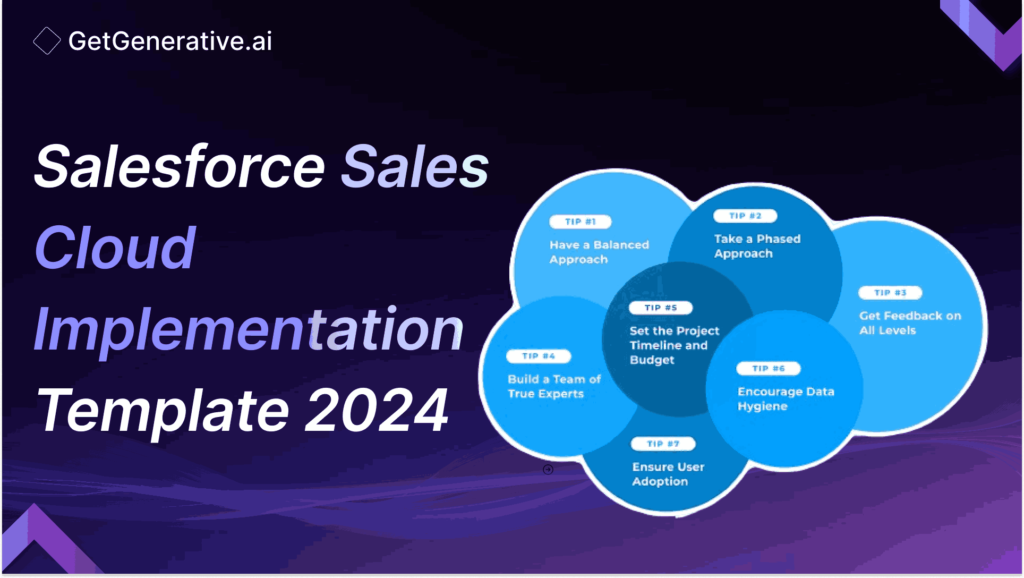Salesforce Sales Cloud Implementation Template 2024
Salesforce Sales Cloud is a powerful CRM tool designed to streamline sales processes, enhance team collaboration, and boost productivity. Implementing Salesforce Sales Cloud effectively requires a well-structured plan that addresses various stages.
Companies implementing Salesforce Sales Cloud have reported a significant increase in sales revenue, with some seeing an average uplift of 37%. Organizations have experienced up to a 44% increase in sales productivity due to the automation of manual processes and improved access to information (Salesforce).
Steps for Salesforce Sales Cloud Implementation
Define Stakeholders and Roles
Identify Key Stakeholders: Engage individuals and teams that will use or be impacted by the system. This includes business/end users, super users, project managers, and decision-makers.
Assign Roles and Responsibilities:
- Business/End Users: Individuals who will use the system daily. Select representatives from each group to provide input on requirements and success criteria.
- Super Users: Eager users who will assist with testing and rollout. They receive specialized training to support their colleagues.
- Project Manager: Responsible for project progress and outcomes. Ensures clear communication and addresses blockers.
- Decision Maker: Authorized to make key decisions on timelines, budgets, and designs.
Set High-Level Goals
Define Success Criteria: Engage stakeholders to understand what success looks like. Ask questions like:
- What are the primary pain points?
- What processes are inefficient?
- What features are most desired?
Align Visions: Ensure all stakeholders have a shared vision and clear objectives for the project.
Gather Requirements
Conduct Workshops and Interviews: Collect detailed requirements from stakeholders. Ensure requirements are:
- Unambiguous: Use precise language.
- Concise: Avoid unnecessary information.
- Testable: Ensure requirements can be verified.
Create User Stories: Capture end-user scenarios and expectations.
Prioritize Requirements
Classify Requirements: Use a High/Medium/Low priority system and identify must-haves, should-haves, and nice-to-haves.
Resource Management: Focus on delivering critical features within the available resources and timelines.
Project Planning and Design
Develop a Comprehensive Plan: Include risk assessment, timeline, and resource allocation.
Choose Implementation Methodology:
- Waterfall: Linear and sequential phases, suitable for projects with well-defined requirements.
- Agile: Iterative development with sprints, allowing flexibility and continuous improvement.
Salesforce Core Build and Customization
Customize Salesforce: Use point-and-click tools and code-based customizations as needed. Involve end users for continuous feedback.
Integrate Systems: Ensure seamless integration with existing applications like ERP or marketing automation tools.
Also Read – Salesforce Service Cloud Implementation Proposal Template
Data Migration
Prepare and Cleanse Data: Ensure data accuracy and integrity before migration.
Use Migration Templates: Utilize predefined templates for accounts, contacts, leads, products, and pricing data.
User Acceptance Testing (UAT)
Conduct Comprehensive Testing: Validate the system against requirements using detailed test cases.
Engage End Users: Involve users in testing to ensure the system meets their needs and expectations.
Training and Go-Live Preparation
Develop Training Materials: Create documentation and conduct training sessions to prepare users.
Plan Communication Strategy: Prepare the organization for the new system with clear communication about the go-live process.
Go-Live and Post-Go-Live Support
Execute Go-Live Plan: Launch the system and provide immediate support to address any issues.
Post-Go-Live Support: Offer ongoing support and make necessary adjustments based on user feedback.
Future Outlook
The future of Salesforce Sales Cloud is promising, with several key trends and developments expected to shape its evolution:
Increased Integration with AI:
- Enhanced Predictive Analytics: AI-driven insights will provide sales teams with more accurate forecasts and recommendations.
- Automated Sales Processes: AI will automate routine tasks, allowing sales reps to focus on high-value activities.
Improved User Experience:
- Customizable Dashboards: Enhanced user interfaces will offer more customization options for sales reps.
- Mobile Optimization: Continued improvements in mobile functionality will ensure sales teams can work effectively from anywhere.
Greater Focus on Data Security:
- Advanced Security Measures: Salesforce will continue to enhance its security protocols to protect sensitive customer data.
- Compliance with Global Standards: Ongoing updates will ensure compliance with evolving data privacy regulations worldwide.
Enhanced Collaboration Tools:
- Integrated Communication Platforms: Tools like Slack will be more deeply integrated, improving team collaboration and communication.
- Real-Time Data Sharing: Faster data-sharing capabilities will enhance decision-making processes.
Expansion of Ecosystem:
- Broader AppExchange Offerings: A growing marketplace of third-party applications will provide more options for customization and enhancement.
- Partnerships with Other Tech Leaders: Collaborations with other technology companies will expand Salesforce’s functionality and reach.
Change Management
Implementing Salesforce Sales Cloud isn’t just about technology; it’s also about people. Effective change management ensures your team is ready and willing to adopt the new system.
Communication Strategy:
- Clear Messaging: Communicate the benefits and reasons for the change clearly and regularly. Highlight how Salesforce Sales Cloud will make their jobs easier and more efficient.
- Feedback Loops: Establish channels for ongoing feedback from users. This helps identify and address any concerns or resistance early on.
Training Programs:
- Tailored Training: Offer customized training programs based on user roles. Sales reps, managers, and support staff may need different training focuses.
- Hands-On Sessions: Provide practical, hands-on training sessions to help users get comfortable with the new system.
Support Systems:
- Dedicated Support Teams: Establish a dedicated team to assist users post-implementation. This team can help troubleshoot issues and provide additional training as needed.
- Continuous Improvement: Use user feedback to improve the system and training programs continuously.
Also Read – Salesforce Einstein AI Proposal Template
Measuring Success and ROI
Tracking the success of your Salesforce Sales Cloud implementation is crucial to understanding its impact and justifying the investment.
Key Performance Indicators (KPIs):
- Sales Metrics: Track lead conversion rates, sales cycle length, and revenue growth. These indicators can provide insights into how the system is improving sales performance.
- User Adoption Rates: Monitor the number of users actively using Salesforce Sales Cloud and how frequently they use it. High adoption rates typically correlate with higher ROI.
Customer Satisfaction:
- Feedback Surveys: Conduct regular surveys to gauge customer satisfaction. Improved customer interactions and satisfaction can indicate successful implementation.
- Net Promoter Score (NPS): Use NPS to measure customer loyalty and satisfaction. An increase in NPS can reflect the positive impact of Salesforce Sales Cloud on customer relations.
Cost Savings:
- Operational Efficiency: Measure the reduced time spent on manual processes and administrative tasks. Salesforce Sales Cloud’s automation features can significantly reduce these times, saving costs.
- Training and Support Costs: Track the costs associated with training and support. Effective training and change management can reduce these costs over time.
By focusing on these areas, organizations can ensure that they implement Salesforce Sales Cloud effectively and maximize their return on investment.
Conclusion
Implementing Salesforce Sales Cloud can significantly transform your sales processes, enhance team collaboration, and boost overall productivity. By following a structured approach, from defining stakeholders to providing post-go-live support, you can ensure a smooth and successful implementation. Keeping an eye on future trends and focusing on effective change management will further maximize the benefits of Salesforce Sales Cloud.
Make your consulting process easier with GetGenerative.ai. Effortlessly create great proposals and focus more on delivering excellent service to your clients.
Start today and revolutionize the way you work.
Frequently Asked Questions (FAQs)
1. What is Salesforce Sales Cloud?
Salesforce Sales Cloud is a CRM platform that supports sales processes, from lead generation to closing deals.
2. How long does it take to implement Salesforce Sales Cloud?
Implementation time varies based on project scope, typically from a few weeks to several months.
3. What are the key steps in Salesforce Sales Cloud implementation?
Key steps include defining stakeholders, setting goals, gathering and prioritizing requirements, planning, customization, data migration, testing, training, going live, and post-going live support.
4. What are the benefits of using Salesforce Sales Cloud?
Benefits include increased sales revenue, improved sales productivity, better lead conversion rates, and enhanced team collaboration.
5. What methodologies can be used for Salesforce implementation?
Common methodologies include waterfall (linear and sequential) and agile (iterative development with sprints).




